Page 190 of 350

CD Loading/Ejecting
To load the CD, insert it gently into the slot to activate the
motorized loading system, which will position it cor-
rectly.
The CD can be loaded with the radio off and the ignition
key turned to ON/RUN. In this case, the radio will
remain off. When the radio is turned on, the last source
listened to before being switched off, will be activated.
When a CD is inserted, the display will show the symbol
“CD” and the wording “CD Reading.” They will remain
displayed for the whole time required for the radio to
read the CD. When this time has elapsed the radio
automatically starts playing the first track.
Press the
button with the radio turned on, to activate
the motorized CD ejection system. After ejection, the last
audio source listened to before playing the CD will be
heard. If the CD is not removed from the radio, it will automati-
cally be reloaded about 20 seconds later but will not
resume playing until the
�MEDIA�button is pressed to
select the CD mode. The radio will switch to the last
source prior to CD mode.
The CD cannot be ejected if the radio is off.
Possible Error Messages
If the loaded CD cannot be read (e.g. a CD ROM has been
inserted or the CD is inserted the wrong way or there is
a reading error) the display shows the wording “CD Disc
error.”
The CD will then be ejected and the audio source
activated before the CD mode selection will be heard.
A CD which cannot be read will not be ejected until these
functions are over. At the end, with the CD mode
activated, the display will show the wording “CD Disc
error” for a few seconds and then the CD will be ejected.
188 UNDERSTANDING YOUR INSTRUMENT PANEL
Page 207 of 350
STARTING AND OPERATING
CONTENTS
�STARTING PROCEDURES ................208
▫ Single-Speed Transmission ...............208
▫ Normal Starting ...................... .208
� SINGLE–SPEED TRANSMISSION ...........209
▫ Key Ignition Park Interlock ...............212
▫ Gear Ranges ........................ .212
▫ Auto Park .......................... .215
� DRIVING ON SLIPPERY SURFACES .........216
▫ Acceleration ........................ .216
▫ Traction ........................... .216�
DRIVING THROUGH WATER .............217
▫ Flowing/Rising Water ..................217
▫ Shallow Standing Water .................217
� POWER STEERING .....................219
� PARKING BRAKE ..................... .220
� BRAKE SYSTEM ...................... .222
▫ Four-Wheel Anti-Lock Brake System (ABS) . . .223
� ELECTRONIC BRAKE CONTROL SYSTEM . . . .224
▫ Anti-Lock Brake System (ABS) ............224
▫ Brake Assist System (BAS) ...............224
5
Page 210 of 350
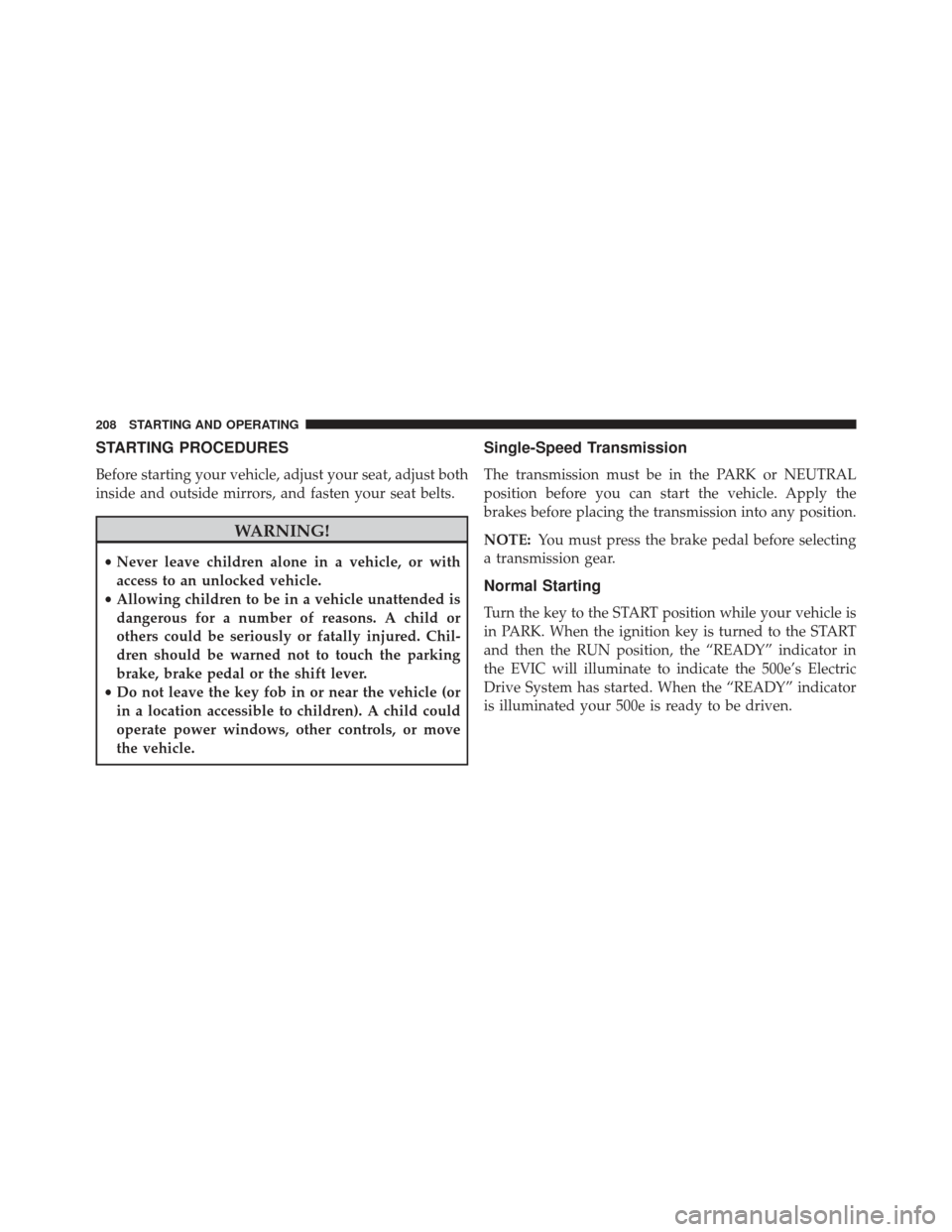
STARTING PROCEDURES
Before starting your vehicle, adjust your seat, adjust both
inside and outside mirrors, and fasten your seat belts.
WARNING!
•Never leave children alone in a vehicle, or with
access to an unlocked vehicle.
• Allowing children to be in a vehicle unattended is
dangerous for a number of reasons. A child or
others could be seriously or fatally injured. Chil-
dren should be warned not to touch the parking
brake, brake pedal or the shift lever.
• Do not leave the key fob in or near the vehicle (or
in a location accessible to children). A child could
operate power windows, other controls, or move
the vehicle.
Single-Speed Transmission
The transmission must be in the PARK or NEUTRAL
position before you can start the vehicle. Apply the
brakes before placing the transmission into any position.
NOTE: You must press the brake pedal before selecting
a transmission gear.
Normal Starting
Turn the key to the START position while your vehicle is
in PARK. When the ignition key is turned to the START
and then the RUN position, the “READY” indicator in
the EVIC will illuminate to indicate the 500e’s Electric
Drive System has started. When the “READY” indicator
is illuminated your 500e is ready to be driven.
208 STARTING AND OPERATING
Page 213 of 350
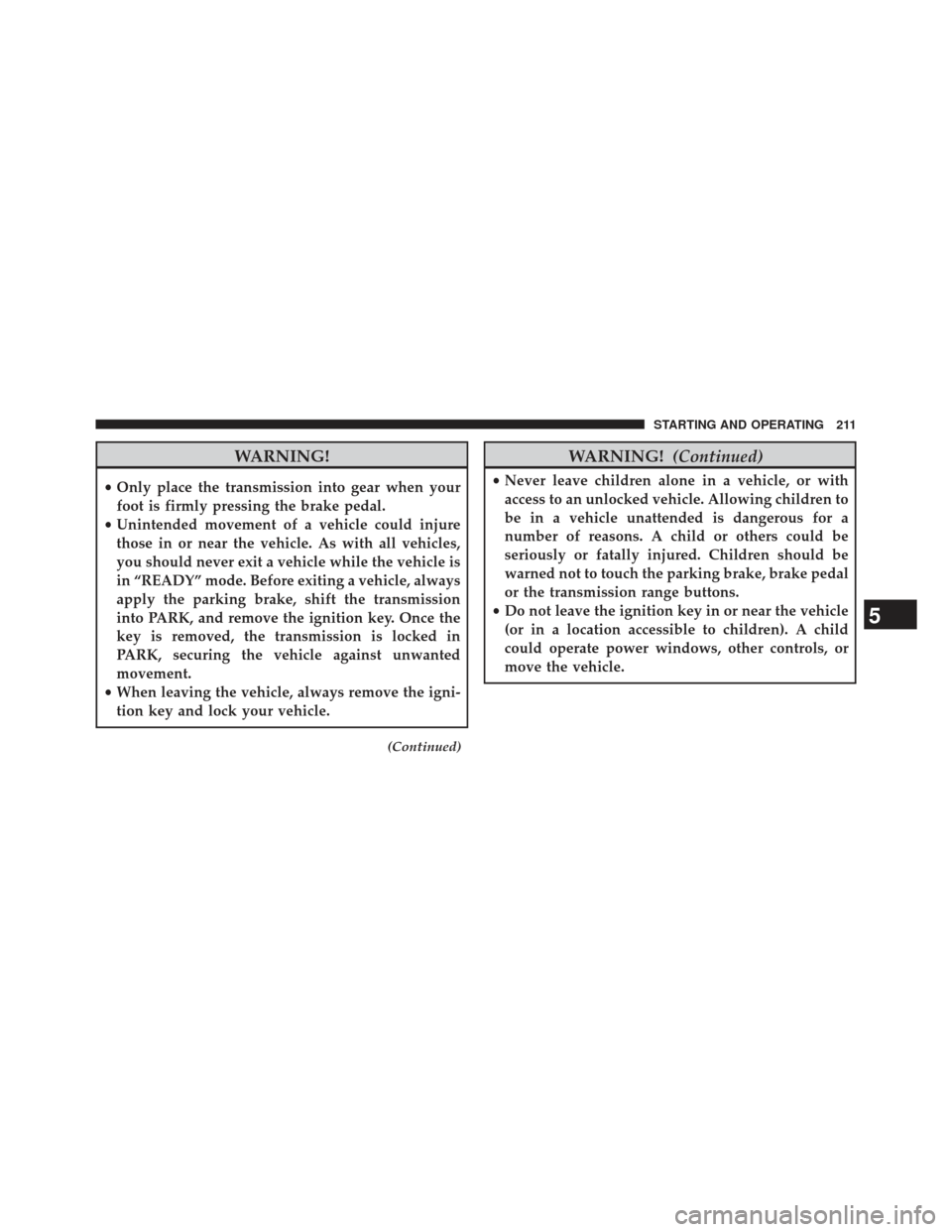
WARNING!
•Only place the transmission into gear when your
foot is firmly pressing the brake pedal.
• Unintended movement of a vehicle could injure
those in or near the vehicle. As with all vehicles,
you should never exit a vehicle while the vehicle is
in “READY” mode. Before exiting a vehicle, always
apply the parking brake, shift the transmission
into PARK, and remove the ignition key. Once the
key is removed, the transmission is locked in
PARK, securing the vehicle against unwanted
movement.
• When leaving the vehicle, always remove the igni-
tion key and lock your vehicle.
(Continued)
WARNING! (Continued)
•Never leave children alone in a vehicle, or with
access to an unlocked vehicle. Allowing children to
be in a vehicle unattended is dangerous for a
number of reasons. A child or others could be
seriously or fatally injured. Children should be
warned not to touch the parking brake, brake pedal
or the transmission range buttons.
• Do not leave the ignition key in or near the vehicle
(or in a location accessible to children). A child
could operate power windows, other controls, or
move the vehicle.
5
STARTING AND OPERATING 211
Page 214 of 350
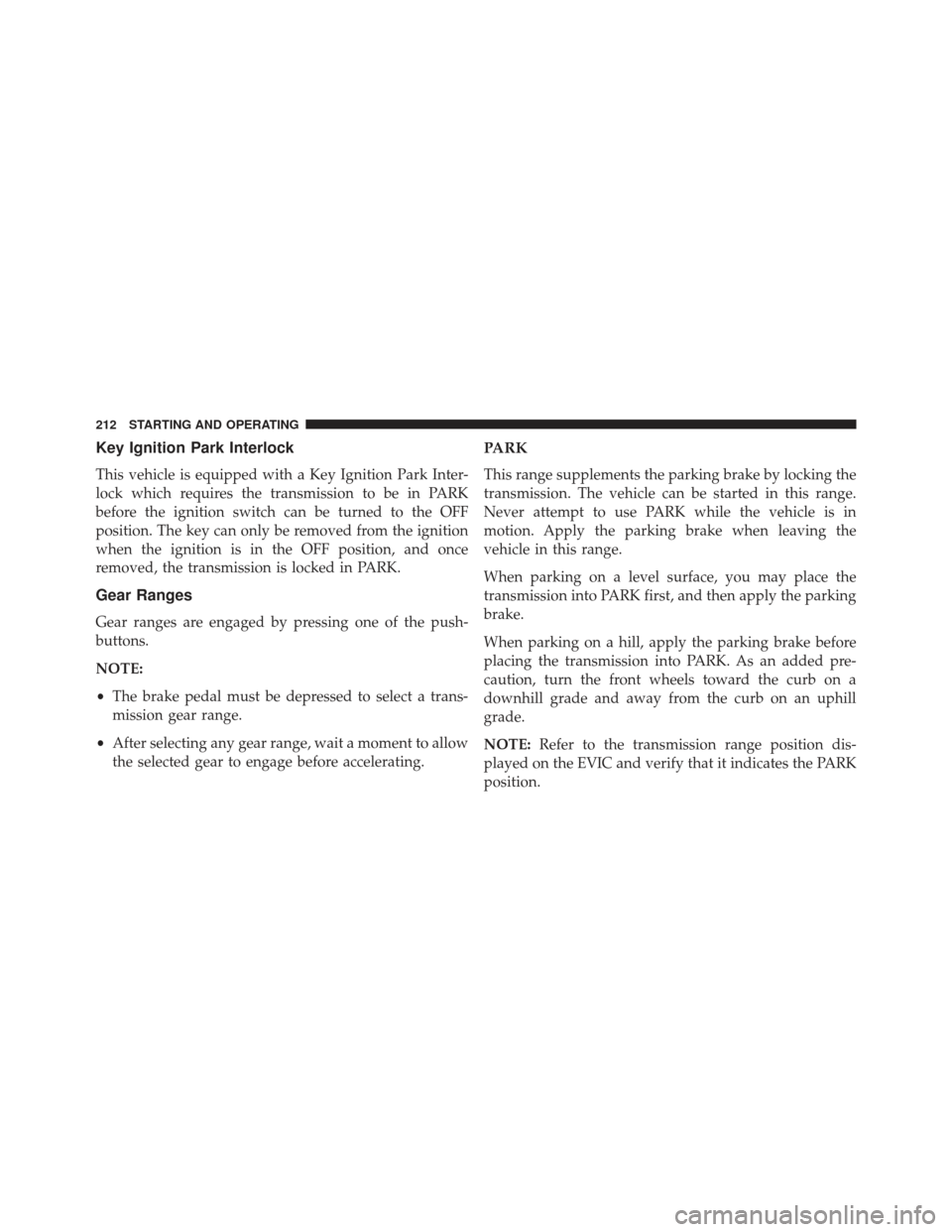
Key Ignition Park Interlock
This vehicle is equipped with a Key Ignition Park Inter-
lock which requires the transmission to be in PARK
before the ignition switch can be turned to the OFF
position. The key can only be removed from the ignition
when the ignition is in the OFF position, and once
removed, the transmission is locked in PARK.
Gear Ranges
Gear ranges are engaged by pressing one of the push-
buttons.
NOTE:
•The brake pedal must be depressed to select a trans-
mission gear range.
• After selecting any gear range, wait a moment to allow
the selected gear to engage before accelerating.
PARK
This range supplements the parking brake by locking the
transmission. The vehicle can be started in this range.
Never attempt to use PARK while the vehicle is in
motion. Apply the parking brake when leaving the
vehicle in this range.
When parking on a level surface, you may place the
transmission into PARK first, and then apply the parking
brake.
When parking on a hill, apply the parking brake before
placing the transmission into PARK. As an added pre-
caution, turn the front wheels toward the curb on a
downhill grade and away from the curb on an uphill
grade.
NOTE: Refer to the transmission range position dis-
played on the EVIC and verify that it indicates the PARK
position.
212 STARTING AND OPERATING
Page 215 of 350
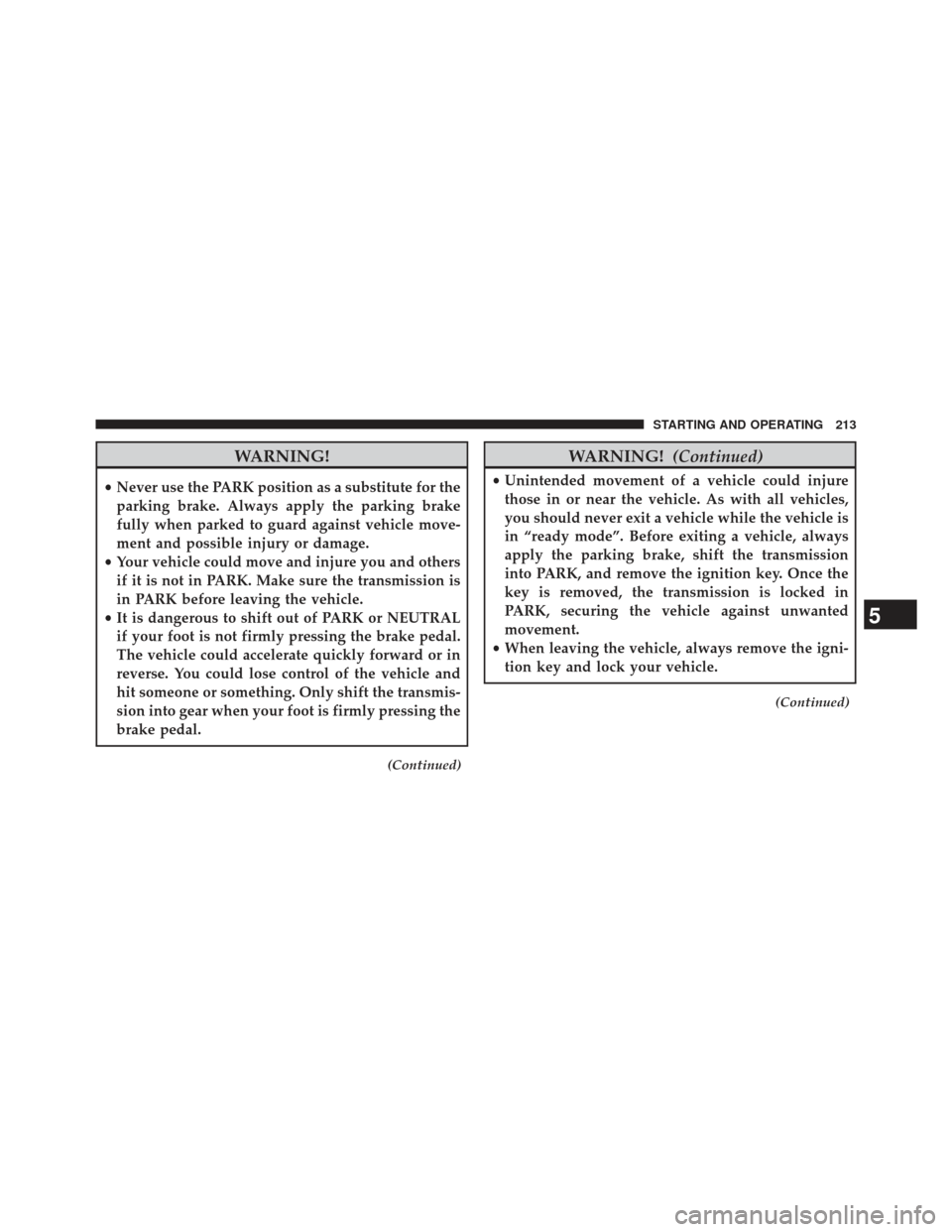
WARNING!
•Never use the PARK position as a substitute for the
parking brake. Always apply the parking brake
fully when parked to guard against vehicle move-
ment and possible injury or damage.
• Your vehicle could move and injure you and others
if it is not in PARK. Make sure the transmission is
in PARK before leaving the vehicle.
• It is dangerous to shift out of PARK or NEUTRAL
if your foot is not firmly pressing the brake pedal.
The vehicle could accelerate quickly forward or in
reverse. You could lose control of the vehicle and
hit someone or something. Only shift the transmis-
sion into gear when your foot is firmly pressing the
brake pedal.
(Continued)
WARNING! (Continued)
•Unintended movement of a vehicle could injure
those in or near the vehicle. As with all vehicles,
you should never exit a vehicle while the vehicle is
in “ready mode”. Before exiting a vehicle, always
apply the parking brake, shift the transmission
into PARK, and remove the ignition key. Once the
key is removed, the transmission is locked in
PARK, securing the vehicle against unwanted
movement.
• When leaving the vehicle, always remove the igni-
tion key and lock your vehicle.
(Continued)
5
STARTING AND OPERATING 213
Page 216 of 350

WARNING!(Continued)
•Never leave children alone in a vehicle, or with
access to an unlocked vehicle. Allowing children to
be in a vehicle unattended is dangerous for a
number of reasons. A child or others could be
seriously or fatally injured. Children should be
warned not to touch the parking brake, brake pedal
or the transmission range buttons.
• Do not leave the ignition key in or near the vehicle
(or in a location accessible to children). A child
could operate power windows, other controls, or
move the vehicle.
REVERSE
This gear range is for moving the vehicle backward. Shift
into REVERSE only after the vehicle has come to a
complete stop.
NEUTRAL
The vehicle may be started in this gear range. Apply the
parking brake and place the transmission into PARK if
you must leave the vehicle.
WARNING!
Do not coast in NEUTRAL and never turn off the
ignition to coast down a hill. These are unsafe
practices that limit your response to changing traffic
or road conditions. You might lose control of the
vehicle and have a collision.
214 STARTING AND OPERATING
Page 223 of 350
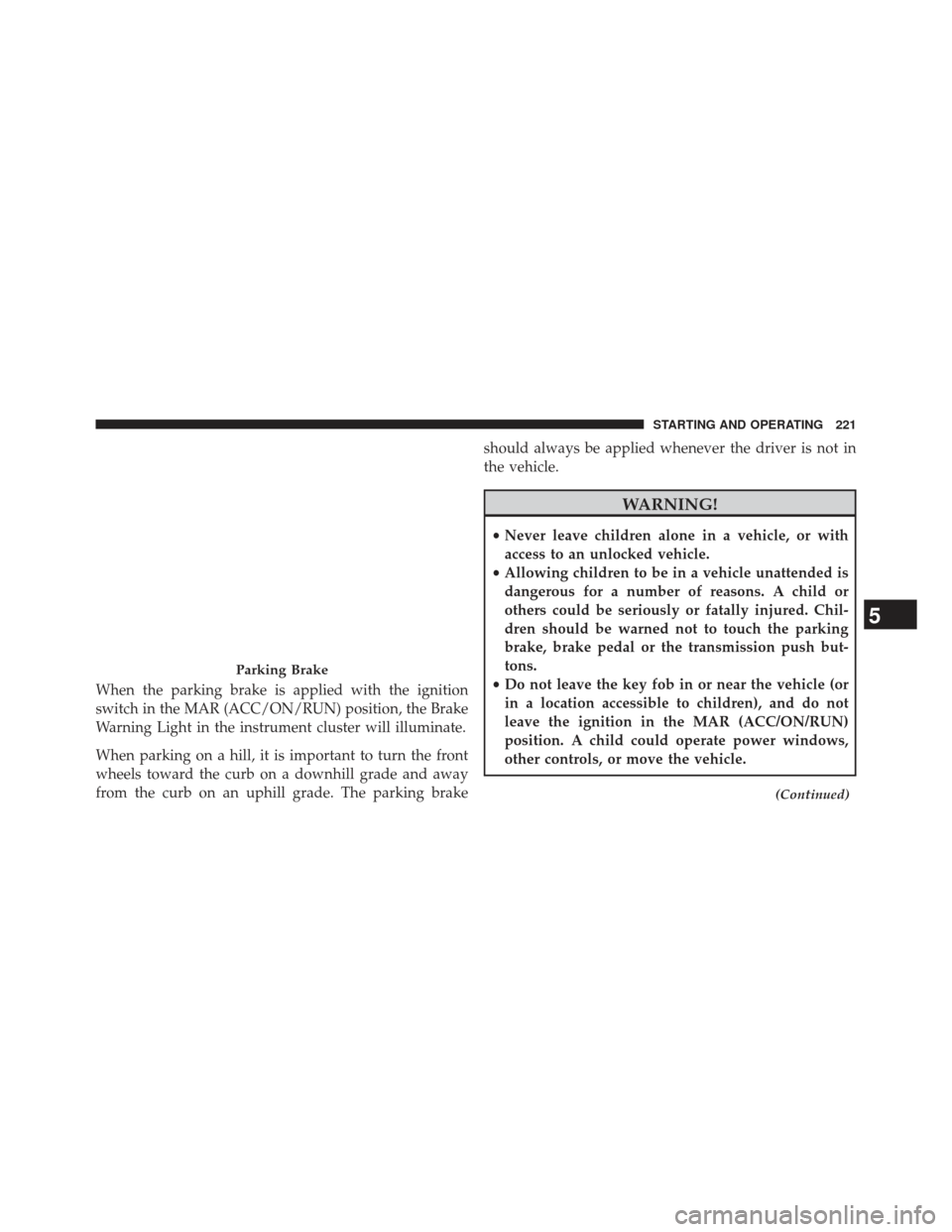
When the parking brake is applied with the ignition
switch in the MAR (ACC/ON/RUN) position, the Brake
Warning Light in the instrument cluster will illuminate.
When parking on a hill, it is important to turn the front
wheels toward the curb on a downhill grade and away
from the curb on an uphill grade. The parking brakeshould always be applied whenever the driver is not in
the vehicle.
WARNING!
•
Never leave children alone in a vehicle, or with
access to an unlocked vehicle.
• Allowing children to be in a vehicle unattended is
dangerous for a number of reasons. A child or
others could be seriously or fatally injured. Chil-
dren should be warned not to touch the parking
brake, brake pedal or the transmission push but-
tons.
• Do not leave the key fob in or near the vehicle (or
in a location accessible to children), and do not
leave the ignition in the MAR (ACC/ON/RUN)
position. A child could operate power windows,
other controls, or move the vehicle.
(Continued)
Parking Brake
5
STARTING AND OPERATING 221